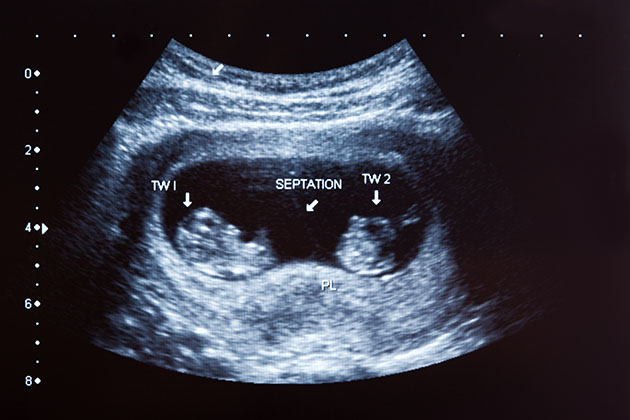Case study reports first rare semi-identical twins in humans to be identified during pregnancy and only second ever known till now
Identical twins (monozygotic) are conceived when cells from a single egg are fertilized by a single sperm and they divide into two post fertilization. Identical twins are always of the same gender and have identical genetic material or DNA. Fraternal twins (dizygotic) are conceived when two eggs are fertilized by two individual sperms and they develop together so they can be of different sexes. Fraternal twins are as genetically similar as siblings of same parents born at a different time.
Semi-identical twins identified during pregnancy
In a case study published in The New England Journal of Medicine researchers at Queensland University of technology, Australia have reported semi-identical twins – a boy and a girl – identified for first time during pregnancy and they are the only second set of such twins known1. During the 28-year-old mothers’ ultrasound at six weeks, it was indicated that identical twins are expected based upon the presence of a single shared placenta and positioning of amniotic sacs. Later at her 14 weeks ultrasound in the second trimester, the twins were seen to be a boy and girl which is only possible for fraternal twins and not identical.
Genetic inspection done by amniocentesis showed that the twins shared 100 percent maternal DNA and for most part one twin received paternal DNA from one set of paternal cells and other twin from the other set. However, some mixture happened during early embryonic development revealing that these twins were not ordinary twins but chimeras i.e. they have cells from different genes. Chimeras are composed of different populations of genetically distinct cells and thus are not genetically uniform. The typical chromosome arrangement for boy is 46XY and girl is 46XX but these twins both have an assortment of female XX cells and male XY cells in varied proportions – meaning that some cells in their body were XX and others XY. The boy had XX/XY chimerism ratio of 47:53 and girl had XX/XY chimerism ratio of 90:10. This conveys the potential domination towards male and female development of the respective twin.
How are semi-identical twins conceived
When a sperm penetrates an egg, the egg’s membrane changes and thus locks out another sperm. In this particular pregnancy, mother’s egg was fertilized simultaneously by two sperms from the father called as ‘dispermic fertilization’ in which two sperms penetrate a single egg. A normal embryo has two sets of chromosomes, one each from mother and father. But if such a simultaneous fertilization takes place, three sets of chromosomes are produced instead of two i.e. one from the mother and two from each sperm of the father. Three sets of chromosomes are incompatible with central dogma of life and therefore such a pregnancy caused by double fertilization is not viable and the embryos do not survive and result in abortion. In this particular rare pregnancy, there might have been a possible failure in some mechanism which prevents polyspermy and thus two sperms fertilized an egg producing three sets of chromosomes. Such a sequence of events is termed as ’heterogonic cell division’ as previously reported in animals. The third chromosome containing material from just the two sperms cannot grow normally so it did not survive. The remaining two typical cell types combined again and continued to grow before splitting into two embryos – a boy and a girl – thus making the twins 78 percent identical on father’s side. The early cells in a zygote are pluripotent meaning that they can develop into any type of cells making development of these cells a possibility.
The twins were 100 percent identical on the mother’s side and 78 percent with the father, so this averages out to being 89 percent identical with each other. In scientific terms, semi-identical twins is a third type of characterization, a rare form of twinning which can be called as an intermediate between identical and fraternal twins and similarity wise they are closer to fraternal twins. It is an extraordinarily rare occurrence, the first ever semi-identical twins were reported in USA in 20072 in which one twin had ambiguous genetilia. And both these twins also got identical chromosomes from mother but got only half of DNA from father. In the current study no ambiguities were reported. At one-point researchers thought of a probability that perhaps these semi-identical twins were not rare and previously reported fraternal twins might actually be semi-identical. However, analysing twin databases showed no previous occurrence of semi-identical twins. Also, genetic data analysis of 968 fraternal twins and their parents showed no indications of semi-identical twins. Though the twins were born healthy via a caesarean delivery, some health complications were reported as the girl post birth and at the age of three. Such complications are a result of mainly the genetic makeup.
***
{You may read the original research paper by clicking the DOI link given below in the list of cited source(s)}
Source(s)
1. Gabbett MT et al. 2019. Molecular Support for Heterogonesis Resulting in Sesquizygotic Twinning. The New England Journal of Medicine. https://doi.org/10.1056/NEJMoa1701313
2. Souter VL et al. 2007. A case of true hermaphroditism reveals an unusual mechanism of twinning. Human Genetics. 121. https://doi.org/10.1007/s00439-006-0279-x






































